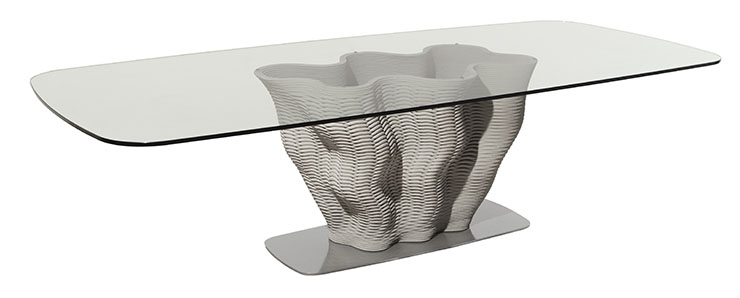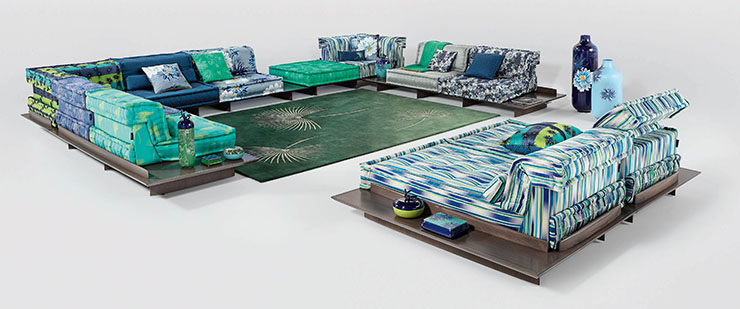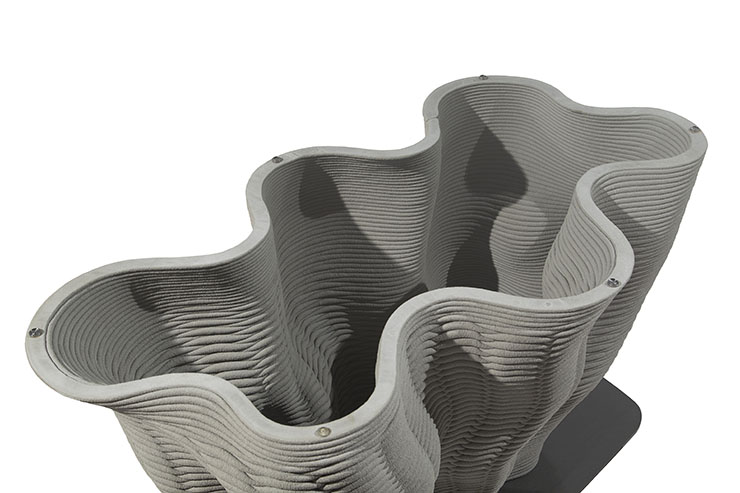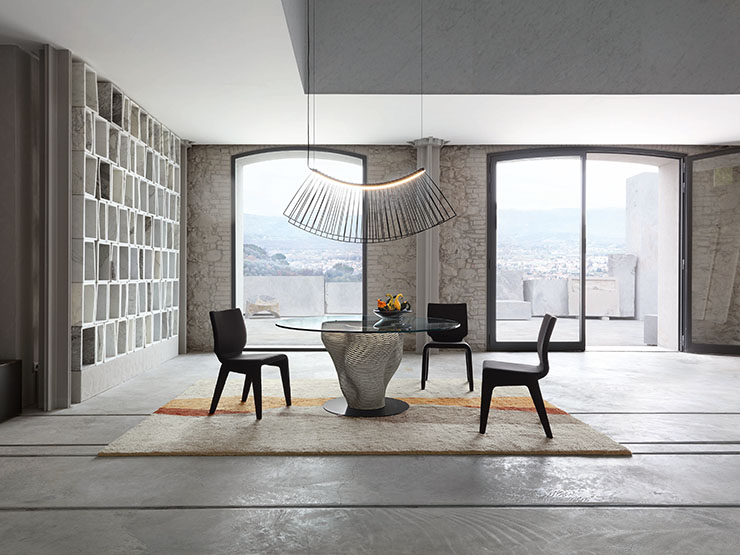Words: Lin Stranberg
This year, Roche Bobois introduced the new Corail dining table, a breakthrough innovation made with large-scale 3D printing technology, customized to match the customer’s unique vision. This bold new innovation is set to change the relationship between consumers and design, and between the industry and its distribution.
The Corail table features an organically shaped base in ultra-high performance concrete (UHPC) with flowing curves that supports a tempered glass top, so the interior of the base is clearly visible from above. Its name translates to coral, which it somewhat resembles.
“We turned to the team of Fritsch and Durisotti as design collaborators,” said Cindy Susilo, Roche Bobois marketing director. “We had worked with them in the past. They had a nautical design background, having designed kayaks and amphibious boats, with the technical expertise that was the right fit for this project.”
Since its beginnings as a Parisian furniture store more than 60 years ago, Roche Bobois has collaborated closely with both design professionals and customers. Most of the items in the product line are customizable in their dimensions, fabric and leather choices as well as in many materials and finishes.

The Corail dining table nudges customization to the next level. When choosing a Corail, a customer can literally design their own table within the parameters of the base design. Using 3D software on the Roche Bobois website or in-store with the help of a Roche Bobois advisor, customers become the designer, choosing the shape and size of the tabletop and the shape, size and complexity of the base, from minimal to exuberantly baroque. And they can apply as much as they wish of the beautiful woven effect the printer will create, wherever in the design they want. Through the configurator, they can see the result come to life.
Purchasers become a force in the design process, the creators of their unique model. Their choices are saved and represent the “genetic code” used by the printer. Once this code has been entered into the printing unit, the 3D automaton is activated. In a continuous upward movement, the digitally operated nozzle pours out a ribbon of concrete in coiled layers, according to the code. The concrete coils harden during the layering process and the base, which takes about half an hour to produce, needs about 10 days to fully dry.
The process is aligned with the Roche Bobois approach to eco-consciousness, which has involved the development of an assessment tool they call Eco8 used to measure the environmental impact of their products. The goal is to produce Corail tables locally. Right now, they are made in France, and it is envisioned that eventually Roche Bobois will be able to simply send a digital file to a local printer equipped with the technology, and considerably reduce the carbon footprint by cutting down on transport.
3D printing, a process of making three-dimensional solid objects from a digital file, has been around for awhile. It is additive in the sense that it creates an object by laying down successive layers of material, rather than subtractive, which involves cutting or hollowing out a piece of metal or plastic using a machine, for example.
It uses less material and can be done wherever an appropriately sized 3D printer is available. Because it streamlines, simplifies and reduces the costs of designing furniture, it has radically impacted the furniture industry. As has often been the case, Roche-Bobois is among the first to use this process to innovate new breakthroughs in furniture.
For example, the Mah Jong modular sofa—now an iconic piece that furnished the outdoor space for nominees and presenters at the 93rd Oscars in Los Angeles—marked a breakthrough in design when it was first created in 1971.
Designed by painter/sculptor Hans Hopfer, the Mah Jong introduced a new freedom in function and form. The pieces could be configured as a sofa, armchair, lounge chair or bed and could be customized with fabrics from internationally-renowned designers. The Mah Jong sofa transformed the concept of furniture. It was a nonconformist design that really took off in those nonconformist times. It was radical then—and is still hugely popular now.
For the 93rd Oscars, Roche Bobois collaborated with the award-winning Rockwell Group, creating various compositions of the Mah Jong modular sofa in an outdoor fabric from MissoniHome. Using the Mah Jong groupings and Cute Cut cocktail tables, fresh and silk florals and lantern lighting, they created a sophisticated and whimsical outdoor space for the exclusive use of the nominees and presenters, in a cool colour palette inspired by the original tile work at Union Station, where the event took place.
This year, Roche Bobois celebrates 50 years of the Mah Jong sofa.
“The Mah Jong has been our number one bestselling sofa in Vancouver and Calgary year after year,” said Ray Deleurme, who has owned the Roche Bobois showroom in downtown Vancouver for 17 years. The brand itself, which has been in Vancouver for more than 35 years, is well-known and has a substantial following of devoted clients.
“Customization is a very popular feature,” Ray said. “Our clientele is exacting and they know just what they want. And with our vast collection, it’s very rare we can’t find something for every client. I am very excited to bring the Corail table to our showroom. I think it is set to become another iconic Roche-Bobois piece and will be the first step in an exciting new direction.”
Cindy Susilo enthusiastically agrees. “The Corail table is opening the door to a variety of exponential possibilities.”

羅奇堡(Roche Bobois)今年推出利用3D打印技術製造的的Corail餐桌,這項突破性的技術創新可以為客戶量身定做,以滿足客戶的獨特創意,並將改變消費者和設計師之間的關係,以及行業與其分銷商之間的關係。
Corail餐桌的特點是一個有機形狀的超高性能混凝土(UHPC)底座,具有流動的曲線,支撐著一個鋼化玻璃桌面,所以從上面可以清楚地看到底座的內部。因爲類似於珊瑚,故此得名。
“我們選擇Fritsch和Durisotti的團隊作為設計合作者,”羅奇堡市場總監Cindy Susilo說。“過往我們曾經合作過。他們有航海設計背景,設計過皮划艇和水陸兩棲船,這一專長對我們的項目再適合不過。”
自從60多年前在巴黎經營第一間家具店開始,羅奇堡就與設計專家和客戶進行了密切合作。在尺寸、織物、皮革選擇、以及許多材料和表面處理方面,產品中的大多數都可以定製。

Corail餐桌將定製推向新的高度。客戶實際上可以在Corail餐桌基礎設計的參數範圍內設計他們自己的桌子。使用羅奇堡網站的3D軟件或在實體店内顧問的協助下,選擇桌面與底座的形狀與大小,從簡約型到繁複的巴洛克風格,客戶也可以成爲設計師。利用打印機,客戶在任何一個細節都可以設計出美麗的編織效果,然後通過配置器,即可以看到設計成爲現實。
客戶參與設計,創造出獨一無二的模型。他們的參數選擇會被保存下來,為打印機提供所謂的 “遺傳代碼”。一旦這個代碼被輸入到打印單元,3D自動機就被激活。在一個連續的向上運動中,數字操作的噴嘴根據代碼以盤繞的方式倒出一條條混凝土帶。混凝土卷在分層過程中變硬,製造底座大約需要半小時,但需要大約10天才可以乾透。
這一生產過程與羅奇堡公司的環保理念相一致,包括開發一個稱之為Eco8的評估工具,衡量產品對環境帶來的影響。現在,Corail餐桌是在法國製造,但公司的目標是可以在世界上任何一個地方生產,希望可以簡單地將數字文件發送給當地配備該技術的打印機,從而減少運輸以及碳排放。
3D打印,一種通過數字文件製造三維實體物體的過程已經存在了一段時間。它是通過連續鋪設材料層來創造一個物體的增材製造的方式,而非減量製造,比方説使用機器切割或挖空一塊金屬或塑料。
這種技術使用的材料更少,只要有適當大小的3D打印機即可完成。由於它精簡、簡化並降低了家具設計的成本,從根本上影響了家具行業,而羅奇堡公司則成爲第一批使用這種工藝打造家具的公司之一。
例如1971年代表著突破性設計的Mah Jong麻將組合沙發,如今已成爲羅奇堡的標志性作品,在洛杉磯第93屆奧斯卡頒獎典禮上為提名人和頒獎人提供了戶外活動空間。
麻將沙發由畫家和雕塑家Hans Hopfer設計,在功能和形式上引入一種新的自由,可以隨意地配置成沙發、扶手椅、休閒椅或床,並可以用國際知名設計師的織物進行定製。作爲一種不拘一格的設計,麻將沙發改變了家具的概念。雖然當時算是相當前衛,但卻在那個不拘一格的時代一炮打響,直到現在仍大受歡迎。
在第93屆奧斯卡頒獎典禮上,羅奇堡與獲獎的Rockwell Group合作,用Missoni Home的戶外面料創造了各種組合的麻將沙發,并且與Cute Cut雞尾酒桌、新鮮的絲質花卉和燈籠照明,營造出一個精緻而奇特的戶外空間,供提名人和主持人專用,其冷色調的靈感來自活動舉辦地聯合車站原始的瓷磚裝飾。
今年,羅奇堡慶祝麻將沙發誕生50週年。在溫哥華市中心擁有羅奇堡陳列室17年Ray Deleurme說:”Mah Jong一直是我們在溫哥華和卡加利最暢銷的沙發。這個品牌在溫哥華有35年以上的歷史,早已眾所周知,擁有大量的忠實客戶。”
“定製非常受歡迎,”Ray說:“我們的客戶很嚴格,他們知道自己想要什麼。由於我們的貨品豐富,總能找到每個客戶的心儀之物。我很高興能把Corail餐桌帶到我們的展廳,我認為它將成為羅奇堡的另一標誌性作品,並在一個令人興奮的新方向上率先邁出第一步。”
Cindy Susilo 大表贊同:“Corail餐桌為家具行業又打開一扇大門,帶來無限可能性。”


 Simone Guo & A tale of the land 畫家郭西萌:為大自然賦予情感
Simone Guo & A tale of the land 畫家郭西萌:為大自然賦予情感